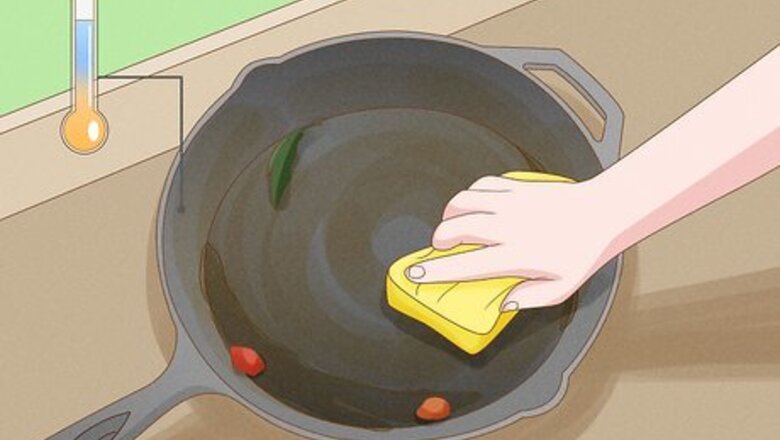
views
Are you looking for how to clean a standalone flat-top griddle? Find out how here.
- Wash your griddle with hot soapy water and a stiff nylon brush after each use.
- Scrub kosher salt into stubborn pieces of food that are stuck to your griddle to clean it without leaving scratches.
- Clean rust off a cast iron griddle by soaking it in vinegar and water for up to 24 hours. Scrub the rest of the rust with steel wool to remove it.
- Dry your griddle and coat the cook surface with a thin layer of vegetable oil.
Cleaning After Cooking
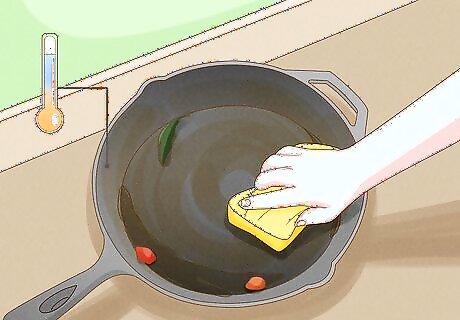
Clean the griddle while it’s still warm. Since your griddle will be extremely hot after you use it, give it a couple of minutes to cool down. When your griddle is cool enough to hold with your bare hands but still a little warm, start cleaning. Food sticks to cast iron as it cools down, so it’s important to clean your griddle within a few minutes of cooking with it.
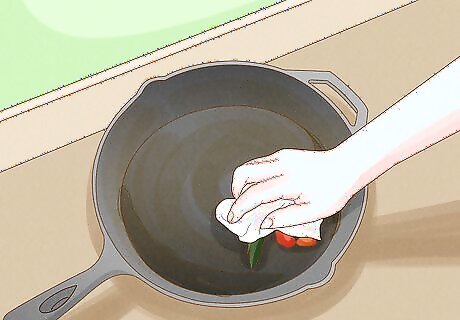
Wipe up large chunks of food with a paper towel. Layer a few pieces of paper towel on the griddle, and wipe down the full length. Collect all of the large pieces of food at one end of the griddle and scoop it into the trash. If your griddle has ridges, wipe the paper towel in the same direction they run so it’s easier to clean. If you’re cleaning a Blackstone cast iron griddle, push all of the food residue into the collection tray at the top of the cooking surface.
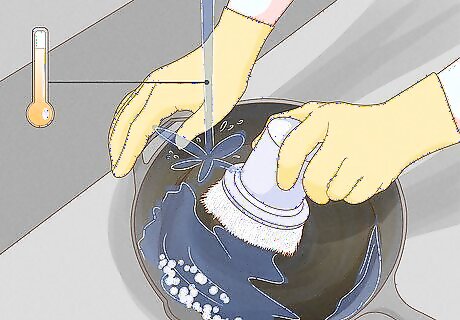
Wash your griddle with a nylon brush and hot soapy water. Fill your sink with the hottest water that you can handle and add a few drops of dish soap. Just dip the bristles of the brush in the soapy water and use them to lightly scrub the griddle’s surface. Rinse the suds off with clean water when you’re finished. Even though you may have heard to never use soap on cast iron, it’s safe and won’t damage your griddle. As long as you aren’t scrubbing really hard, you won’t remove your griddle’s seasoning. Avoid using cold water since the temperature difference when it comes into contact with your griddle could make it crack or warp. Avoid letting your cast iron griddle soak in water since it could make rust form more quickly.
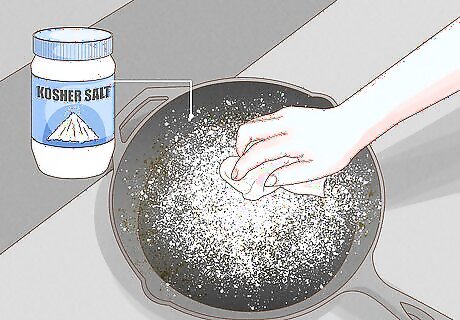
Remove stuck-on food with a kosher salt scrub. Sprinkle a handful of coarse kosher salt onto your griddle’s cooking surface. Put a paper towel or sponge on top of the salt and apply light pressure to scrub away stubborn residue. Then, just rinse the griddle off with warm water. If there’s still stuck food residue, use a wooden pan scraper to get rid of it.
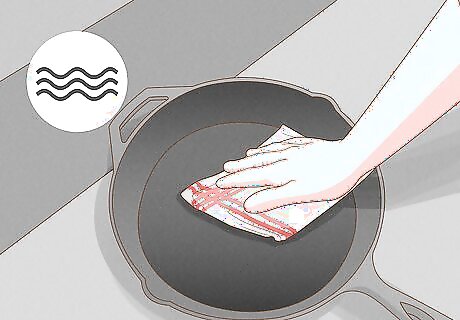
Dry your griddle with a towel. Try to get your griddle as dry as possible with paper towels or a kitchen towel. That way, you ensure there’s no water on the surface that could turn into rust. Avoid leaving your cast iron griddle to air-dry since the water will sit on the surface and cause corrosion.
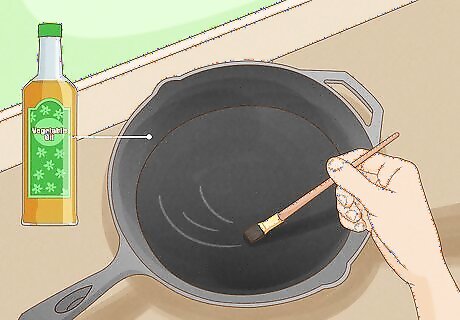
Apply vegetable oil to the griddle’s cooking surface. While your cast iron griddle is still warm, wet a paper towel with vegetable oil and coat your griddle. Once you spread the oil into a thin layer, wipe up the excess so it doesn’t pool on the surface. The layer of oil helps preserve the non-stick surface as well as prevents rust from forming. Avoid using olive oil, sesame oil, coconut oil, or flaxseed oil since it has a lower smoke point and will burn off of the surface faster.
Restoring a Griddle with Rust
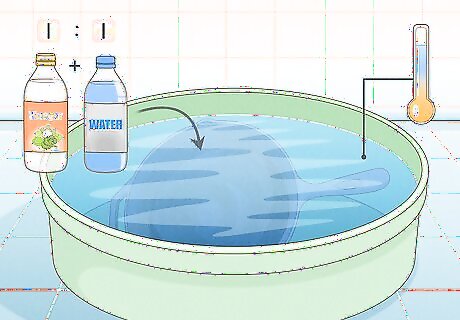
Soak the griddle in a vinegar solution to break apart rust. Fill a plastic container or bucket with equal parts warm water and distilled white vinegar. Completely submerge your griddle in the solution so it can start breaking down the rust on the surface. After 1 hour, check if the rust has completely broken down. If not, leave your griddle in the solution. As soon as the vinegar lifts a majority of the rust, take your griddle out and rinse it off. Avoid leaving your griddle in the vinegar solution for longer than 24 hours since it could start breaking down the metal underneath the rust. For an extremely rusty griddle, use a rust eraser to scrape the rust off. While you normally shouldn’t scraping cast iron since it removes seasoning, you need to re-season your griddle after removing rust anyway.
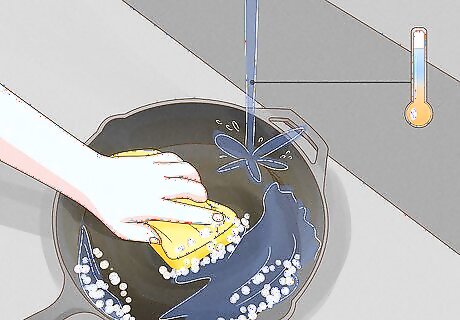
Wash your griddle with warm soapy water. Mix a few drops of regular dish soap into a sink with warm water. Wet the griddle with the soapy water, and use a nylon scrub brush to gently break apart all the loose rust particles on the surface. Then, just rinse the griddle off with warm water to get rid of all the suds. Some people recommend not using soap since it could remove the griddle’s non-stick seasoning. If your griddle has rust, then the seasoning has already worn off, so it’s okay to use soap.
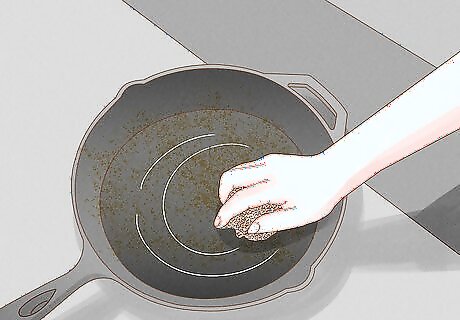
Scrub rust particles off with steel wool or a chainmail scrubber. If there’s still rust particles stuck to the surface, wet your griddle with warm water. Then, apply gentle pressure as you scrub with your steel wool or chainmail. Work across the griddle’s cooking surface and occasionally rinse it off to check if you removed all of the rust. For really stubborn rust, sprinkle a degreaser like Easy-Off onto your griddle before using the steel wool.
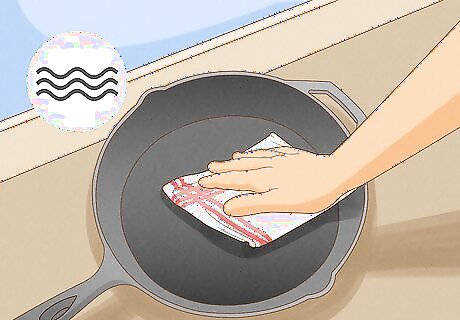
Dry your griddle with a towel. Use paper towels or a kitchen towel to soak up as much water as you can. Make sure there isn’t any moisture or standing water on your griddle since it could cause rust to form.
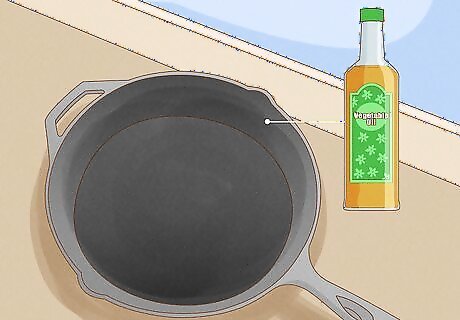
Season your griddle with vegetable oil. Since you removed the outer layer of rust on your griddle, it won’t have a non-stick seasoning anymore. Wet a paper towel with vegetable oil and rub it over the griddle’s surface. If you have a Blackstone griddle or one built into your gas stove, just coat the cooking surface.
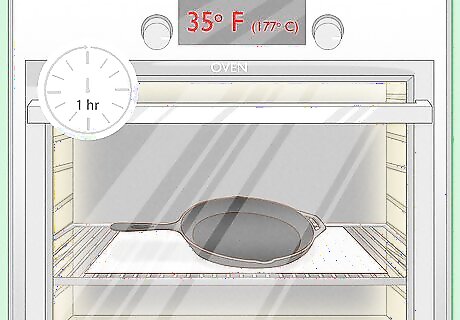
Heat your griddle in the oven at 350 °F (177 °C) for 1 hour. Set the griddle upside-down on a baking sheet so it doesn’t drip. Put the baking sheet with your griddle in the oven and let it heat up for 1 hour so the oil creates the non-stick seasoning. For a built-in griddle on a gas stove, heat the griddle with the burners instead of putting it in your oven.
Caring for Cast Iron
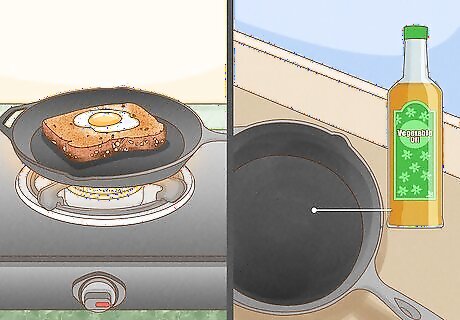
Clean and oil your griddle after each use. You may have heard the myth that you don’t need to clean your cast iron, but it’s still important to prevent rust from forming. After you finish cooking, just take a few minutes to wash your griddle. Then, rub a thin layer of vegetable oil onto the surface to preserve the non-stick surface and prevent rust.
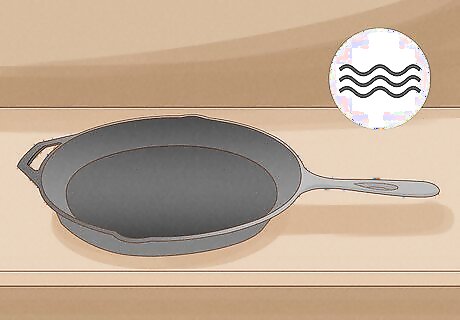
Store your griddle in a dry place. Make sure your griddle is completely dry when you put it away. Put the griddle in a cabinet or leave it on your stovetop so it’s ready to use. Alternatively, put the griddle in your oven so it’s ready to warm up the next time you cook with it. If you’re stacking other items on your griddle, put a paper towel or kitchen towel between each one to prevent scratches in your cast iron.
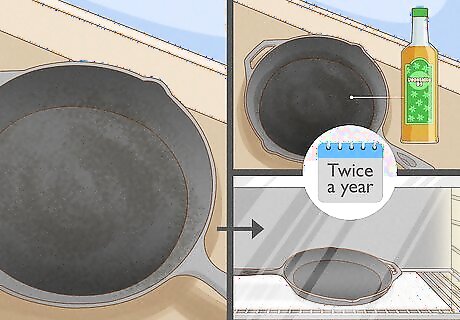
Re-season your griddle once or twice a year. When your griddle looks dull or when food starts sticking to the surface, season your griddle. Wash off the old seasoning from the griddle and apply a new layer of oil to the surface. Then, heat the griddle to bake the oil into the surface so it’s non-stick and protected from rust. You may need to re-season your cast iron griddle more often if you frequently cook acidic foods since they eat through the seasoning faster.




















Comments
0 comment